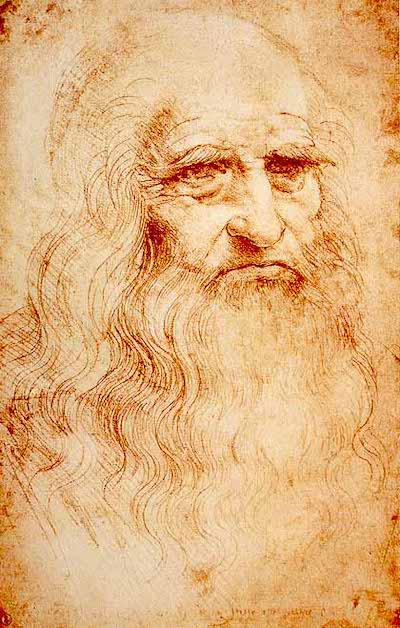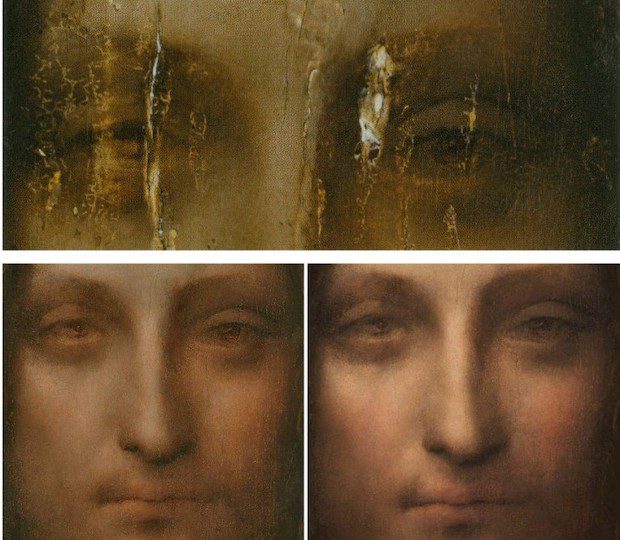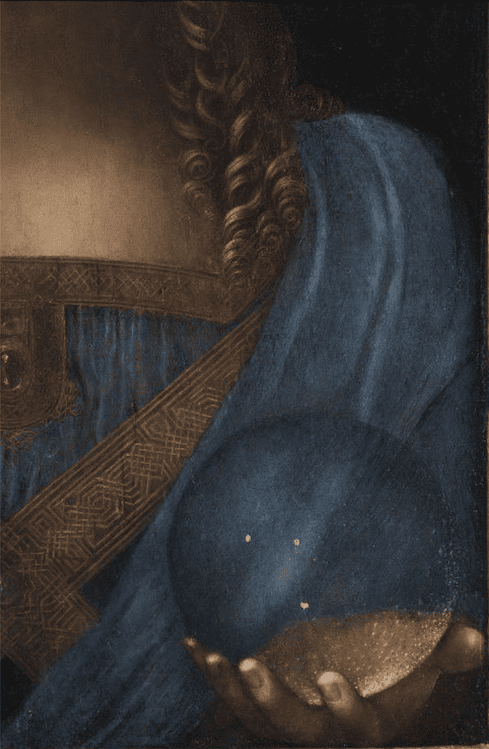The highest price achieved by a painting is that of “Salvator Mundi” *, attributed to Leonardo da Vinci, sold for $ 450.3 million at Christie’s in New York on November 15, 2017.
We knew that the work had been purchased by Prince Mohammed Ben Salman of Saudi Arabia. What we did not know was that the sub-bidder was Prince Mohammed Ben Zayed of the United Arab Emirates, which was discovered following various inquiries by numerous journalists.
Therefore, when the latter indirectly asked Prince Ben Zayed why he had bid against his friend Ben Salman, they were told by the secretariat that the Prince was unaware that his friend Ben Salman had bought it. Let us be clear: it is unthinkable and unimaginable because the two men know each other well, have the same concerns, are in business and friendly relations, between them and with the seller: the Russian oligarch Dmitry Rybolovlev, of the immediate entourage from President Putin.
The first three seem to have been glimpsed shortly before the painting goes on sale … There are therefore many questions. They form the basis of the article by American journalist Zev Shalev of January 2, 2019, to which we refer the reader. *
This sale is the illustration of several phenomena
-The taking in hand of the artistic trade of the highest level by private investors.
-The transformation of the art market into a stock exchange where all excesses are allowed, following the influx of capital from people who have made their fortunes in the digital world, in the industry of emerging countries, and the diversification of the introduction dollars.
All this without forgetting, however, a corollary: the use of money of dubious origin.
-To make the possession of exceptional works of art a proof of personal success,
-The irresistible attraction of a myth of art and history.
First downside
The painting was to be shown at the Louvre Abu Dhabi, according to the announcement made on December 9, 2017. It has never been exhibited. No explanation for this delay has been given. By now, it seems to have disappeared from circulation: officially no one knows where it is, not even its owner.
This painting, dated without question to the beginning of the sixteenth century, has undergone countless vicissitudes. Its multiple owners are not all identified, only a few.

Sanguine sur papier, 33cm/21,6. Bibliothèque royale de Turin
The horrific “restorations” he suffered massacred him, making it even more difficult to judge his autograph.
The debate around the painting is very violent, passionate and heavy with innuendo given the price reached. One can imagine the consequences of a definitive classification of the work in the corpus of Bernardino Luini, to which it has always been attached, to the detriment of Leonardo da Vinci: millions of dollars would go up in smoke! It would be a Wall Street collapse-type disaster of 1929, but this time in the art market: it is the credibility of experts and auction operators that is at stake. The stakes are therefore enormous, disproportionate.
We will analyze the table, trying not to forget any aspect. We will do it as objectively as we can, without any partisan polemics. We will draw our conclusions from it. We will not engage in any discussion, will not comment on each other’s opinions; the reader will judge.
The technical analysis of the pigments is said to be: “globally compatible with Leonardo da Vinci“. No specific information was given to the public: were modern imaging techniques used? Mystery … No dating has been proposed either.
Another unknown: Leonardo being left-handed, we would like to know if any brushstrokes made with the left hand were spotted on this painting. To our knowledge, no authorized person has communicated on this subject.
The walnut wood support
The board was exploded into several pieces which were glued together. It is not known where, when and how the event or events occurred. The technique of cutting wood is currently being analyzed: is it “unwinding” with parallel fracture levels typical of the sixteenth century, or “slicing” with the curved and mechanical fracture lines of the tenth century? ninth century? The results are expected to be released in 2019 and are expected to include a dating. At the moment, what has been proven is that the photos taken before refurbishment tend more towards the second possibility. But the extent of the restorations is such that it also concerns the support …
As a result of these breaks, the work has so many shortcomings that it can be described as a “ruin” before restoration. True vertical slashes were strewn over it, in the face and around it. The hair appeared faded, like the folds of clothes and the globe. In fact, the missing and repainted concern the WHOLE painting, with the partial exception of the blessing hand. Christ stands out against a completely repainted dark background, which stifles the subject’s vision. Under these conditions, it is no longer a question of restoration but of reinvention, recreation and reconstitution!
There are three proven drawings of Leonardo da Vinci which appear in relation to our subject: a head of Christ, a garment and a right hand. Repentances are visible up close on the painting, so the experts brought him closer to Leonardo.
Now let’s look at the painting. So the face is seen entirely from the front. It is totally fixed, almost rigid. What surprises with Leonardo, where everything is always in motion and of an obvious organic life, but not as much as the axis of symmetry which divides this figure into two equal hemispheres! This hieratism is unthinkable with the Master. All the more so since the consequence can be seen immediately: the frontierness of the character represented. These two considerations alone exclude any Leonardo autography of the work.

Let us continue our work of analysis: the absence of depth is obvious to the viewer whose feeling is to see a flat work, without depth and without volumetric density. The right eye is bigger than the left. Both are globular, expressionless, no spark of spirituality inherent in Leonardo’s work animates them. This heavy face is expressionless, dull, inert. The neck is poorly proportioned. The hair is better treated: the curls are fairly well rendered but they suffer from a crippling defect because they are identical on each side, and no breath animates them, and Leonardo knew that the Hebrew word rouah just as well means “wind” that “divine spirit”. He played on this ambivalence in a number of paintings, notably in “Saint-Jean Baptiste” or in “La Vierge aux Rochers”, both at the Louvre.
The treatment of the chin is incredibly awkward, unimaginable in Leonardo. The wrist and the arm protrude heavily from the sleeve, they show no finesse of execution, only softness. Another improbable detail in Leonardo: Christ shows deformed shoulders, the left being higher than the right. The appearance of the folds of the coat is flat and inept commonplace. The borders of the folds and ornaments are plainly decorative, descriptive, not playing any active role. Now, we have known for a long time that all the elements of a Leonardo painting participate in the organic life of the work taken as a whole.

As for the crystal sphere carried by the left hand, it definitively demonstrates that the painting is not by the Master: we do not see any refraction of the clothing located behind the object! Leonardo would have, inevitably and necessarily, taken into account the effect of induced optical distortion of shapes.
Now, let’s take a close look at the only part of the painting that is partially intact: the raised hand in blessing. It is without consistency, like apparent flesh. The fingers have no life, are stunted. The record for absurdity is broken by the middle finger, which is in a totally impossible position compared to others: you just have to try the posture to be convinced!
The main reason for the success of contemporary art is that there is no such thing as forgeries, since one can ask the living artist if the proposed work is indeed his. The only things that count are lobbying, flair, hype and, to a much lesser degree, artistic flair.
It is quite different with what is older: fakes abound. The novice amateur should train his taste, be helped by specialists, competent and honest experts. It is clear that a multibillionaire has more immediate concerns.
This painting is a demonstration of what is called “the waking dream” of the art world: the discovery of a painting by the mythical artist Leonardo da Vinci.
However, the dream in this way can become so powerful that it ends up causing the dreamer to lose all caution and end up in a nightmare. Considering the sky-high price tag, the buyer is on the safe side. But this catastrophe will mean that we will probably never see him again in an unhealthy art market, because it has become a delirious speculative bubble allowing all the excesses … Unless, of course, this whole thing has been set up from scratch?
This is the basic problem: the art market has become a Russian roulette wheel, a formidable machine for speculating and creating profits, sometimes as miraculous as they are artificial. No one knows the origins of payment funds. Institutions, wealthy individuals, speculative funds, invest all the time … Without knowing anything about it. Even international high finance has set about it, hence the risks of using non-equity capital, and therefore of tricks and manipulation, even of laundering dirty money.
What about the painting entitled “Judith and Holofernes“, discovered in Toulouse and whose attribution, no less than adventurous, to Caravaggio leaves you speechless? We remain confused, even shocked, at this absurd paternity given the mediocre quality of the work. It is understandable that an auction under such a prestigious name would achieve a staggering price.
It was the same problem with this “Salvator Mundi”, for which the suspicions of confusion, multiple and varied are whispered so loudly that all can hear it …
*Article originally published in WUKALI on 08/03/2019 under the title: Le Salvator Mundi attribué à Léonard de Vinci, réalité ou colossale escroquerie financière ?
Excerpts from the article published by Zev Shalev …
Dmitry Rybolovlev’s story is typical of many Russian oligarchs. He made his fortune as a potash miner until the Kremlin became interested in him. He settles in Monaco. He bought the luxurious building “La Belle Epoque” by the sea, the AC Monaco football team, 10% of the Bank of Cyprus and made a name for himself in the principality. In March, the Daily Mail revealed that the counter-bidder was Abu Dhabi Crown Prince Mohammed bin Zayed (MbZ). The princes said they did not know the other was bidding and they called it a mistake (…)
He also met Swiss art dealer Yves Bouvier, from whom he bought around $ 2 billion worth of art. Rybolovlev officially paid Bouvier a commission of 2% per painting, but later learned that the Swiss art dealer was also acting on behalf of the seller, fixing prices and pocketing the margin with the buyer’s commissions and the seller.
This is how Rybolovlev became the owner of the Salvator Mundi for $ 127 million, instead of $ 80 million. The two men have since quarreled in court. Both were arrested. And Rybolovlev is suing Sotheby’s for knowing and not saying he was being ripped off. The case itself could be a scam: Money launderers sue each other to wash their money with a judge’s order.
Since March 2013, “Salvator Mundi” worth $ 127 million has been hanging in the Rybolovlev penthouse in New York. Rybolovlev sees no shame in losing $ 47 million on the purchase of the masterpiece. This isn’t the first time someone has accused him of paying too much.
The art of the deal
$ 300 million. This is the incredible profit Rybolovlev made from the sale of Salvator Mundi. 300 million dollars is also the sum “accidentally” paid by Crown Prince Mohammed bin Salman (acting through an intermediary) for the work.
At first, laundering hundreds of millions of dollars for a global audience may not seem like the smartest solution, but the facts corroborate these facts, perhaps this is what the two Crown Princes and Dmitry Rybolovlev attempted to do. make.
Rybolovlev auctioned the masterpiece through Christie’s in November 2017. Lot 9B was estimated to cost between $ 80 million and $ 120 million. Christies auctioneers were stunned when auctions quickly surpassed $ 80 million in seconds, then just as easily as over $ 130 million. Two anonymous bidders continuously outbid each other, not stopping until they’ve hit a price tag of up to $ 450.3 million, making it the most expensive piece of art ever to be auctioned.
In the days that followed, The New York Times discovered that Crown Prince Mohamed bin Salman was the true buyer of this masterpiece, but the identity of the second bidder remained hidden for months.
In March, the Daily Mail revealed that the counter-bidder was Abu Dhabi’s Crown Prince Mohammed bin Zayed (MbZ). The princes said they did not know the other was bidding and they called it a mistake (…)
Complementary article : Salvator Mundi by Leonardo da Vinci, a highly controversial $ 450.3 million facelift


